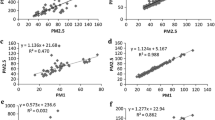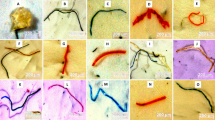Abstract
PM10 concentration and its elemental content were measured inside a university classroom where painting and sketching activities took place. The primary goal was to investigate the impact of these activities to (1) indoor PM10 concentrations, (2) identify PM10 levels in the presence/absence of the activities and (3) investigate the corresponding impact on its elemental content. As such, indoor online measurements and 24-h gravimetric measurements took place at short-term fixed periods. Outdoor PM10 concentrations were also available. It was found that PM10 levels were substantially increased during the occupied hours with average PM10 during activity ranged between 19 and 171 μg/m3, whereas during background periods it ranged between 12 and 66 μg/m3. Moreover, indoor concentrations during the activity were usually higher compared to outdoor levels, but the opposite behavior was found for background periods. Regarding the elemental content, positive correlations of heavy metals (Cu, Zn, Pb, Ba) found predominantly in the coarser fraction were associated with the use of painting powders. On the other hand, metals like Cr, Mn, Fe and Ni were primarily associated with anthropogenic sources, while the crustal origin of Ti, Mg and Al dominated indoors for particles > 1 μm. Other correlations between elements in the submicron fraction suggested origin from soil and anthropogenic sources as well as aged painting-originated particles. In summary, the present study demonstrated the significant impact of painting/sketching activities to indoor PM10 levels. Direct emissions from the use of powders as well as resuspension activities of the occupants were identified as the major indoor sources that provoked elevated concentrations.






Similar content being viewed by others
References
Abdullahi KL, Saborit-Delgado JM, Harrison RM (2013) Emissions and indoor concentrations of particulate matter and its specific chemical components from cooking: a review. Atmos Environ 71:260–294
Al-Awadi L, Al-Rashidi M, Pereira B, Pillai A, Khan A (2019) Indoor air quality in printing press in Kuweit. IJEST 16:2643–2656
Al-Harbi M (2019) Impact of tobacco smoke on the elemental composition of indoor different particles sizes. IJEST 16:2861–2875
Bai L, He Z, Chen W, Li N, Sun S (2019) Investigation of PM2.5 absorbed with heavy metal elements, source apportionment and their health impacts in residential houses in the North-east region of China. Sustain Cities Soc 51:101690
Becerra JA, Lizana L, Gil M, Barrios-Padura A, Blondeau P, Chacartegui R (2020) Identification of potential indoor air pollutants in schools. J Clean Prod 242:118420
Benabed A, Boulbair A, Liman K (2020) Experimental study of the human walking-induced fine and ultrafine particle resuspension in a test chamber. Build Environ 171:106655
Ben-David T, Wang S, Rackes A, Waring MS (2018) Measuring the efficacy of HVAC particle filtration over a range of ventilation rates in an office building. Build Environ 144:648–656
Bhangar S, Mullen NA, Hering SV, Kreisberg NM, Nazaroff WW (2011) Ultrafine particle concentrations and exposure in seven residences in northern California. Indoor Air 21:132–144
Bolourchi A, Atabi F, Moattar F, Ehyaei MA (2018) Experimental and numerical analyses of particulate matter concentrations in underground subway station. IJEST 15:2569–2580
Can E, Üzmez ÖÖ, Dӧğeroğlu T, Gaga EO (2015) Indoor air quality assessment in painting and printmaking department of a fine arts faculty building. Atmos Pollut Res 6(6):1035–1035
Carrer P, Wargocki P, Fanetti A, Bischof W, De Oliveira FE, Hartmann T, Kephalopoulos S, Palkonen S, Seppänen O (2015) What does the scientific literature tell us about the ventilation-health relationship in public and residential buildings? Build Environ 94:273–286
Chatoutsidou SE, Ondráček J, Tesar O, Tørseth K, Zdimal V, Lazaridis M (2015) Indoor/outdoor particulate matter number and mass concentration in modern offices. Build Environ 92:462–474
Chatoutsidou SE, Serfozo N, Glytsos T, Lazaridis M (2017) Multi-zone measurement of particle concentration in a HVAC building with massive printer emissions: influence of human occupation and particle transport indoors. Air Qual Atmos Health 10:679–693
Chen C, Zhao B (2011) Review of relationship between indoor and outdoor particles: I/O ratio, infiltration factor and penetration factor. Atmos Environ 45:275–288
Diapouli E, Chaloukakou A, Koutrakis P (2013) Estimating the concentration of indoor particles of outdoor origin: A review. J Air Waste Manage 63:1113–1129
Ferro AR, Kopperud RJ, Hildemann L (2004) Source strengths for indoor human activities that resuspend particulate matter. Environ Sci Technol 38:1759–1764
Fromme H, Diemer J, Dietrich S, Cyrys J, Heinrich J, Lang W, Kiranoglu M, Twardella D (2008) Chemical and morphological properties of particulate matter (PM10, PM2.5) in school classrooms and outdoor air. Atmos Environ 42(27):6597–6605
Gemenetzis P, Moussas P, Arditsoglou A, Samara C (2006) Mass concentration and elemental composition of indoor PM2.5 and PM10 in university rooms in Thessaloniki, northern Greece. Atmos Environ 40(17):3195–3206
Glytsos T, Ondráček J, Džumbová L, Kopanakis I, Lazaridis M (2010) Characterization of particulate matter concentrations during controlled indoor activities. Atmos Environ 44:1539–1549
Hussein T (2017) Indoor-to-outdoor relationship of aerosol particles inside a naturally ventilated apartment: a comparison between single-parameter analysis and indoor model simulation. Sci Total Environ 596–597:321–330
Kopanakis I, Chatoutsidou SE, Glytsos T, Lazaridis M (2018) Impact from local sources and variability of fine particle number concentration in a coastal sub-urban site. Atmos Res 213:136–148
Lazaridis M, Dzumbova L, Kopanakis I, Ondracek J, Glytsos T, Aleksandropoulou V, Voulgarakis A, Katsivela E, Mihalopoulos N, Eleftheriadis K (2008) PM10 and PM2.5 levels in the eastern Mediterranean (Akrotiri research station, Crete, Greece). Water Air Soil Pollut 189:85–101
Lazaridis M, Serfozo N, Chatoutsidou SE, Glytsos T (2015) New particle formation events arising from painting materials in an indoor microenvironment. Atmos Environ 102:86–95
Lazaridis M, Katsivela E, Kopanakis I, Raisi L, Mihalopoulos N, Panagiaris G (2018) Characterization of airborne particulate matter and microbes inside cultural heritage collections. J Cult Heritage 30:136–146
Manousakas M, Eleftheriadis K, Papaefthymiou H (2013) Characterization of PM10 sources and ambient air concentration levels at Megalopolis city (southern Greece) located in the vicinity of lignite-fired plants. AAQR 13:804–817
Martins V, Faria T, Diapouli E, Manousakas MI, Eleftheriadis K, Viana M, Almeida SM (2020) Relationship between indoor and outdoor size-fractioned particulate matter in urban microenvironments: levels, chemical composition and sources. Environ Res 183:109203
Morawska L, Salthammer T (2003) Indoor environment, airborne particles and settled dust. WILEY-VCH Verlag GmbH & Co. KGaA
Morawska L, Ayoko GA, Bae GN, Buonanno G, Chao CYH, Clifford S, Fu SC, Häninnen O, He C, Isaxon C, Mazaheri M, Salthammer T, Waring MS, Wierzbicka A (2017) Airborne particles in indoor environment of homes, schools, offices and age care facilities: The main routes of exposure. Environ Int 108:75–83
Nasir ZA, Colbeck I (2013) Particulate pollution in different housing types in a UK suburban location. Sci Total Environ 445–446:165–176
Othman M, Latif MT, Mohamed AF (2016) The PM10 compositions, sources and health risks assessment in mechanically ventilated office buildings in an urban environment. Air Qual Atmos Health 9:597–612
Pallarés S, Gómez ET, Martínez A, Jordán MM (2019) The relationship between indoor and outdoor levels of PM10 and its chemical composition at schools in a coastal region in Spain. Heliyon 5(8):e02270
Park JS, Jee N-Y, Jeong J-W (2014) Effects of types of ventilation system on indoor particle concentrations in residential buildings. Indoor Air. https://doi.org/10.1111/ina.12117
Qian J, Peccia J, Ferro AR (2014) Walking-induced particle resuspension in indoor environments. Atmos Environ 89:464–481
Quang TN, He C, Morawska L, Knibbs LD (2013) Influence of ventilation and filtration on indoor particle concentrations in urban office buildings. Atmos Environ 79:41–52
Safar AN, Yassin MF, Hamoda MF (2019) Indoor and outdoor air concentrations of volatile organic compounds in schools within different urban areas. IJEST 16:2831–2838
Salthammer T, Schripp T, Uhde E, Wensing M (2012) Aerosols generated by hardcopy devices and other electrical appliances. Environ Pollut 169:167–174
Schibuola L, Tambani C (2020) Indoor environmental quality classification of school environments by monitoring PM and CO2 concentration levels. Atmos Pollut Res 11(2):332–342
Schripp T, Kirsch I, Salthammer T (2011) Characterization of particle emission from household electrical appliances. Sci Total Environ 409:2534–2540
Serfozo N, Chatoutsidou SE, Lazaridis M (2014) The effect of particle resuspension during walking activity to PM10 mass and number concentrations in an indoor microenvironment. Build Environ 82:180–189
Torkmahalleh MA, Goldasteh I, Zhao Y, Udochu NM, Rossner A, Hopke PK, Ferro AR (2012) PM2.5 and ultrafine particles emitted during heating of commercial cooking oils. Indoor Air 22:483–491
Wedepohl KH (1995) The composition of the continental crust. Geochim Cosmochim Acta 59:1217–1232
Zhang J, Wu L, Zhang Y, Li F, Fang X, Mao H (2019) Elemental composition and risk assessment of heavy metals in the PM10 fractions of road dust and roadside soil. Particuology 44:146–152
Acknowledgement
This work was supported by the European Union’s LIFE Programme in the framework of the Index-Air LIFE15 ENV/PT/000674 project.
Author information
Authors and Affiliations
Contributions
All authors participated materially in the present study. DA, SP and ML contributed to the study conception and design. Data collection was performed by CP and IK; analysis was performed by SEC. The manuscript was written by SEC, CP and the final version was approved by all authors.
Corresponding author
Ethics declarations
Conflict of interest
The authors declare that they have no conflict of interest.
Ethical approval
This article does not contain any studies with human participants or animals performed by any of the authors.
Additional information
Editorial responsibility: Samareh Mirkia.
Rights and permissions
About this article
Cite this article
Chatoutsidou, S.E., Pantelaki, C., Kopanakis, I. et al. Mass concentration and elemental content of PM10 during painting/sketching activities in a university classroom. Int. J. Environ. Sci. Technol. 18, 1061–1072 (2021). https://doi.org/10.1007/s13762-020-02917-4
Received:
Revised:
Accepted:
Published:
Issue Date:
DOI: https://doi.org/10.1007/s13762-020-02917-4




